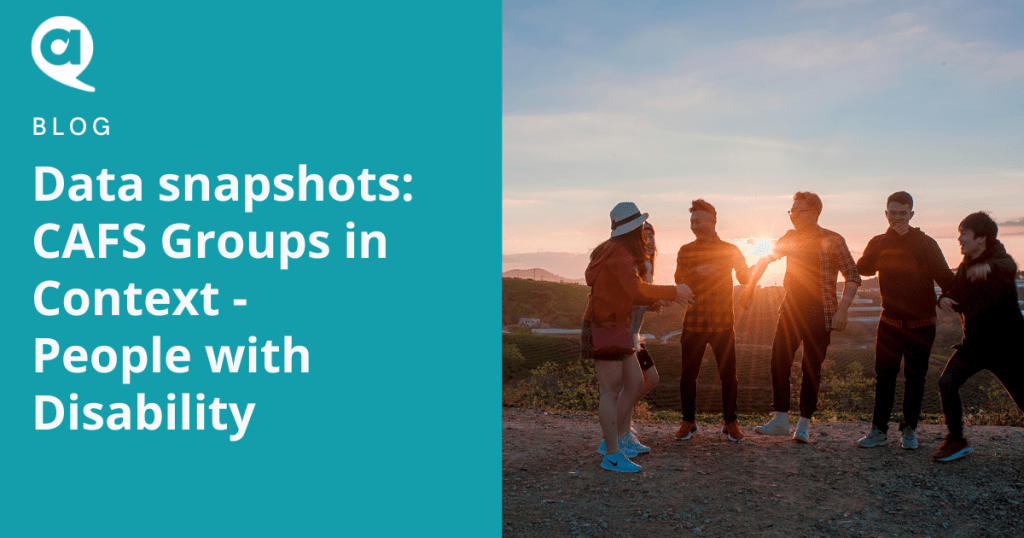
June 2023
Last year the Australian Institute of Health and Welfare released the report Australia’s Health 2022. ACHPER NSW has compiled data from the report to support teaching CAFS Groups in Context. Snapshot #2 looks at People with Disability.
Syllabus learn about:
Exploring the four specific groups within the community
– prevalence of each group within the community
– individual diversity within each group.
Syllabus learn to:
Utilise reliable sources of data to examine the nature of each group by considering the following questions:
– what is the prevalence of the group within Australia?
– what determines whether an individual is part of the group?
– how might individuals vary within the group?
What is the prevalence of the group within Australia?
- Around 1 in 6 (18%) people in Australia – or about 4.4 million – have a disability
- Around 1 in 3 (32%) people with disability have severe or profound disability (about 1.4 million)
- For 1 in 4 (23%) people with disability, their main form of disability is mental or behavioural
- The prevalence of disability generally increases with age. This means the longer people live, the more likely they are to experience some form of disability:
- 7.6% of children aged 0–14 have disability
- 9.3% of people aged 15–24 have disability
- 13% of people aged 15–64 have disability
- 50% of people aged 65 and over have disability (ABS 2019b).
Source: People with Disability in Australia
Teacher note – this source also provides a more detailed breakdown of disability types.
What determines whether an individual is part of the group?
The Disability Discrimination Act 1992 defines ‘disability’ as:
- total or partial loss of the person’s bodily or mental functions; or
- total or partial loss of a part of the body; or
- the presence in the body of organisms causing disease or illness; or
- the presence in the body of organisms capable of causing disease or illness; or
- the malfunction, malformation or disfigurement of a part of the person’s body; or
- a disorder or malfunction that results in the person learning differently from a person without the disorder or malfunction; or
- a disorder, illness or disease that affects a person’s thought processes, perception of reality, emotions or judgment or that results in disturbed behaviour;
and includes a disability that:
- presently exists; or
- previously existed but no longer exists; or
- may exist in the future (including because of a genetic predisposition to that disability); or
- is imputed to a person.
Source: Definition of disability
How might individuals vary within the group?
Sensory disability – includes loss of sight, loss of hearing and speech difficulties.
Physical disability – includes breathing difficulties, blackouts, seizures or loss of consciousness; chronic or recurring pain or discomfort; incomplete use of arms or fingers; difficulty gripping or holding things; incomplete use of feet or legs; restriction in physical activities or work; and disfigurement or deformity.
Psychosocial disability – includes nervous or emotional conditions, mental illness, memory problems or periods of confusion, and social or behavioural difficulties.
General overview
The age distribution of people with disability differs substantially by disability group:
- People with sensory or speech disability are most likely to be aged 65 and over; this is in contrast to the Australian population as a whole where most people are aged under 65.
- The proportion of people aged under 25 is higher in people with intellectual disability than in the total population.
- Most people with physical disability are between ages 55 and 84.
- Most people with head injury, stroke or acquired brain injury are aged 45 and over
- People with psychosocial disability are distributed more evenly across all age groups than any other disability group.
Severe or profound disability
Differences by level of disability, differences can be seen among children and people in older age groups:
- 6.0% of males and 3.0% of females aged 0–14 have severe or profound disability
- 3.6% of males and 3.3% of females aged 15–24 have severe or profound disability
- 3.2% of males and females aged 15–64 have severe or profound disability
- 15% of males and 20% of females aged 65 and over have severe or profound disability (ABS 2019b).
Sensory or intellectual disability
Generally, the prevalence of all disability groups increases with age, but for some disability groups there is also a decrease around the early adulthood years. This is especially true for males:
- 4.2% (or 100,000) of males aged 0–14 have sensory disability compared with 1.8% (or 30,000) of those aged 15–24 and 1.1% (or 20,000) of those aged 25–34
- 5.8% (or 139,000) of males aged 0–14 have intellectual disability compared with 4.9% (or 79,000) of those aged 15–24 and 1.6% (or 30,000) of those aged 25–34 (ABS 2019b).
Girls aged 0–14 are less likely to have sensory disability or intellectual disability than boys, but they also have a decrease in prevalence of these 2 types of disability in early adulthood:
- 2.1% (or 47,000) of females aged 0–14 have sensory disability compared with 1.6% (or 24,000) of those aged 15–24 and 0.9% (or 17,000) of those aged 25–34
- 3.1% (or 71,000) of females aged 0–14 have intellectual disability compared with 2.9% (or 44,000) of those aged 15–24 and 1.3% (or 23,000) of those aged 25–34 (ABS 2019b).
Psychosocial disability
Boys aged 0–14 are more likely (3.4% or 83,000) to have psychosocial disability than girls (1.9% or 43,000).
There is an increase in psychosocial disability in both males (4.5% or 71,000) and females (4.4% or 68,000) at age 15–24 and then a decrease at age 25–34 (2.8% or 51,000 and 2.6% or 48,000 respectively) (ABS 2019b).
Physical and sensory disability
The prevalence of physical disability and sensory disability increases sharply after age 35–44:
- 5.6% (or 183,000) of people aged 35–44 have physical disability and 1.5% (or 49,000) have sensory disability
- 11% (or 335,000) and 3.3% (or 103,000) of those aged 45–54
- 19% (or 535,000) and 6.3% (or 180,000) of those aged 55–64
- 28% (or 617,000) and 16% (or 366,000) of those aged 65–74
- 40% (or 482,000) and 30% (or 357,000) of those aged 75–84
- 58% (or 285,000) and 50% (or 246,000) of those aged 85 and over.
Females aged 85 and over are more likely to have physical disability (63% or 192,000) and less likely to have sensory disability (47% or 141,000) than males (50% or 94,000 and 56% or 105,000 respectively) (ABS 2019b).
Intellectual disability, psychosocial disability, and head injury, stroke or acquired brain injury
The prevalence of intellectual disability, psychosocial disability, and head injury, stroke or acquired brain injury increases considerably from age 65–74:
- 2.7% (or 59,000) of people aged 65–74 have intellectual disability, 5.2% (or 62,000) of those aged 75–84, and 17% (or 81,000) of those aged 85 and over
- 5.5% (or 122,000) of people aged 65–74 have psychosocial disability, 9.4% (or 112,000) of those aged 75–84, and 25% (or 124,000) of those aged 85 and over
- 2.9% (or 64,000) of people aged 65–74 have head injury, stroke or acquired brain injury, 3.9% (or 47,000) of those aged 75–84, and 7.4% (or 36,000) of those aged 85 and over (ABS 2019b)
Females aged 85 and over are more likely to have intellectual disability (19% or 57,000) or psychosocial disability (27% or 82,000) than males (13% or 24,000 and 22% or 41,000 respectively) (ABS 2019b).
Teaching notes
- Make use of the interactive graphs on the AIHW website. The graphs show differences in age, sex and type of disability.
- The AIHW report People with a Disability 2022 is a good source of information.
Useful links
- ABS Disability, Ageing and Carers, Australia: Summary of Findings
- Australian Federation of Disability Organisations – Poverty and Disability
- PWDA Language Guide: A guide to language about disability
- Australian Network on Disability – Disability Statistics
- Australian Human Rights Commission – Include Ability


